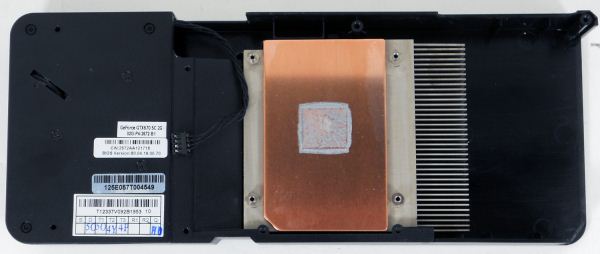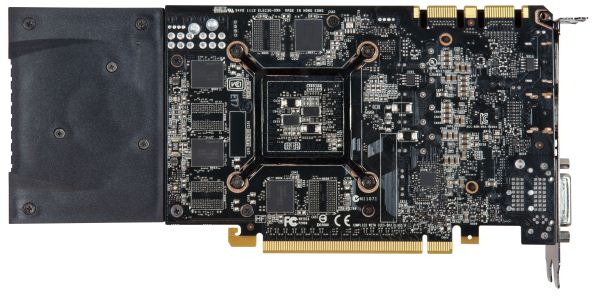NVIDIA GeForce GTX 670 Review Feat. EVGA: Bringing GK104 Down To $400
by Ryan Smith on May 10, 2012 9:00 AM ESTMeet The GeForce GTX 670
Because of the relatively low power consumption of GK104 relative to past high-end NVIDIA GPUs, NVIDIA has developed a penchant for small cards. While the GTX 680 was a rather standard 10” long, NVIDIA also managed to cram the GTX 690 into the same amount of space. Meanwhile the GTX 670 takes this to a whole new level.
We’ll start at the back as this is really where NVIDIA’s fascination with small size makes itself apparent. The complete card is 9.5” long, however the actual PCB is far shorter at only 6.75” long, 3.25” shorter than the GTX 680’s PCB. In fact it would be fair to say that rather than strapping a cooler onto a card, NVIDIA strapped a card onto a cooler. NVIDIA has certainly done short PCBs before – such as with one of the latest GTX 560 Ti designs – but never on a GTX x70 part before. But given the similarities between GK104 and GF114, this isn’t wholly surprising, if not to be expected.
In any case this odd pairing of a small PCB with a large cooler is no accident. With a TDP of only 170W NVIDIA doesn’t necessarily need a huge PCB, but because they wanted a blower for a cooler they needed a large cooler. The positioning of the GPU and various electronic components meant that the only place to put a blower fan was off of the PCB entirely, as the GK104 GPU is already fairly close to the rear of the card. Meanwhile the choice of a blower seems largely driven by the fact that this is an x70 card – NVIDIA did an excellent job with the GTX 560 Ti’s open air cooler, which was designed for the same 170W TDP, so the choice is effectively arbitrary from a technical standpoint (there’s no reason to believe $400 customers are any less likely to have a well-ventilated case than $250 buyers). Accordingly, it will be NVIDIA’s partners that will be stepping in with open air coolers of their own designs.
Starting as always at the top, as we previously mentioned the reference GTX 670 is outfitted with a 9.5” long fully shrouded blower. NVIDIA tells us that the GTX 670 uses the same fan as the GTX 680, and while they’re nearly identical in design, based on our noise tests they’re likely not identical. On that note unlike the GTX 680 the fan is no longer placed high to line up with the exhaust vent, so the GTX 670 is a bit more symmetrical in design than the GTX 680 was.

Note: We dissaembled the virtually identical EVGA card here instead
Lifting the cooler we can see that NVIDIA has gone with a fairly simple design here. The fan vents into a block-style aluminum heatsink with a copper baseplate, providing cooling for the GPU. Elsewhere we’ll see a moderately sized aluminum heatsink clamped down on top of the VRMs towards the front of the card. There is no cooling provided for the GDDR5 RAM.

Note: We dissaembled the virtually identical EVGA card here instead
As for the PCB, as we mentioned previously due to the lower TDP of the GTX 670 NVIDIA has been able to save some space. The VRM circuitry has been moved to the front of the card, leaving the GPU and the RAM towards the rear and allowing NVIDIA to simply omit a fair bit of PCB space. Of course with such small VRM circuitry the reference GTX 670 isn’t built for heavy overclocking – like the other GTX 600 cards NVIDIA isn’t even allowing overvolting on reference GTX 670 PCBs – so it will be up to partners with custom PCBs to enable that kind of functionality. Curiously only 4 of the 8 Hynix R0C GDDR5 RAM chips are on the front side of the PCB; the other 4 are on the rear. We typically only see rear-mounted RAM in cards with 16/24 chips, as 8/12 will easily fit on the same side.
Elsewhere at the top of the card we’ll find the PCIe power sockets and SLI connectors. Since NVIDIA isn’t scrambling to save space like they were with the GTX 680, the GTX 670’s PCIe power sockets are laid out in a traditional side-by-side manner. As for the SLI connectors, since this is a high-end GeForce card NVIDIA provides 2 connectors, allowing for the card to be used in 3-way SLI.
Finally at the front of the card NVIDIA is using the same I/O port configuration and bracket that we first saw with the GTX 680. This means 1 DL-DVI-D port, 1 DL-DVI-I port, 1 full size HDMI 1.4 port, and 1 full size DisplayPort 1.2. This also means the GTX 670 follows the same rules as the GTX 680 when it comes to being able to idle with multiple monitors.
















414 Comments
View All Comments
anubis44 - Saturday, May 12, 2012 - link
4th fastest card, eh? Have a look at these benchmarks, that actually show what the 7970 is capable of if it's OC'd to 1250MHz on the core (1870MHz memory) -- something most 7970s will do, and very few websites have been showing. To be fair, they also OC'd the GTX670 pretty much as far as it would go, too, 1330MHz on the core (1542MHz memory).http://vr-zone.com/articles/gigabyte-gtx-670-oc-wi...
At 1080p, a resolution the GTX680/GTX670 cards often do better in than 2560x1920 or higher. The 7970 wins handily on all but one benchmark (Heaven), and it's only very slightly behind on that one.
I think all AMD has to do is release 1200MHz versions of the 7970 and maybe 1050MHz versions of the 7950 and price them at about ~$400 (you can already buy 7970s for ~$450 right now) and $350 respectively. That should take quite a bit of the wind out of nVidia's sails.
CeriseCogburn - Sunday, May 13, 2012 - link
Not true.http://hwbot.org/hardware/videocard/radeon_hd_7970...
Average air OC on 7970 is 1,204 and average memory overclock is no where near 7,480 up from the stock 5,500
You've got a look at a golden sample there bub, and NO ONE is going to run that sustained clock in 24/7 gaming without some very expensive water cooling or the like and a really good warranty since burnout is likely.
CeriseCogburn - Sunday, May 13, 2012 - link
You're not going to run those overclocks on the cheapo $450 Powercolor 7970 card bub.Spin, spin spin.....
Assimilator87 - Thursday, May 10, 2012 - link
I've been rocking a 470 since it launched and there still isn't a card really worth upgrading to for F@H. 6% faster than a 580 for a supposed next gen part is abysmal. Where is REAL Kepler!?raghu78 - Thursday, May 10, 2012 - link
RyanFrom your HD 7950 review
http://www.anandtech.com/show/5476/amd-radeon-7950...
2560 X 1600 Extreme Quality 4X AA
HD 7970 - 52
HD 7950 - 47
1920 x 1080 Extreme Quality 4X AA
HD 7970 - 82
HD 7950 - 73
From your GTX 670 review
2560 X 1600 Extreme Quality 4X AA
HD 7970 - 59
HD 7950 - 47
1920 x 1080 Extreme Quality 4X AA
HD 7970 - 93
HD 7950 - 73
In the GTX 670 review the HD 7970 has improved its performance greatly while the HD 7950 has not moved a bit. This has got to be a mistake. AMD's latest 12.4 Catalyst drivers have improved 4XAA, 8XAA performance significantly. Please make the corrections.
just4U - Thursday, May 10, 2012 - link
Perhaps he doesn't have a 7950 on hand to do that with? Anyway.. I think there is alot of untapped potential with the 7X top end cards that can only be improved upon down the road with future updates to drivers.bjacobson - Thursday, May 10, 2012 - link
What happens to the boost frequencies with V-sync enabled? This could help a lot with minimums in some games.CeriseCogburn - Friday, May 11, 2012 - link
Uh... we can't test that, because amd can't do that, and amd stutters and crap with v-sync, and that would be an opressed amd card unfairly discriminated against if we did try that adaptive v-sync that ups the minimum frame rate of the nVidia card, heightens the overall frame rate, and smooths out the game. We do affirmative action here for amd.How mean are you trying to be to amd man ? No way man !
Menty - Thursday, May 10, 2012 - link
Just wanted to say thanks for including the 5870 on most of the review graphs. I've got one and it's really nice to see if the upgrade is worth it. Not that I can decide, but it's nice to have the numbers anyway! :)SlyNine - Thursday, May 10, 2012 - link
I upgraded to a 680GTX from 5870. The times that the 5870 struggled most is when this card is the biggest improvement.Cyrsis 2 when the walker shoots that bright light thing. That killed my 5870, like 5-10fps (DX 9, highest settings at release). But the 680GTX is around 30 FPS with much much higher settings. ( DX11, high res texture pack) Its def 2x the performance and more. When the performance dived on the 5870 seems to be where this card is more like 3x faster and more consistent.